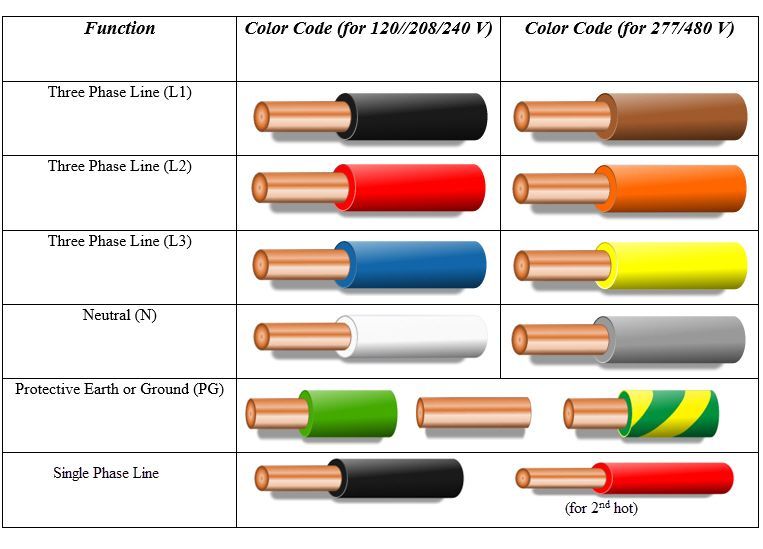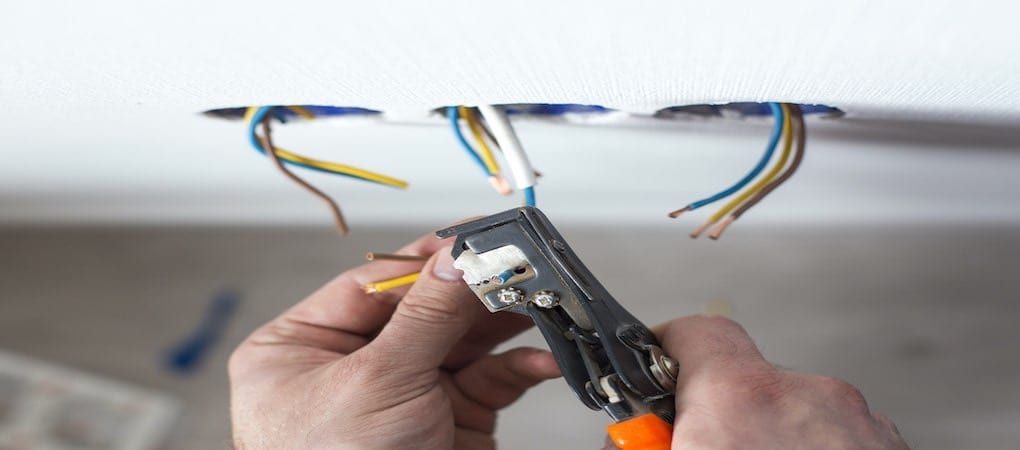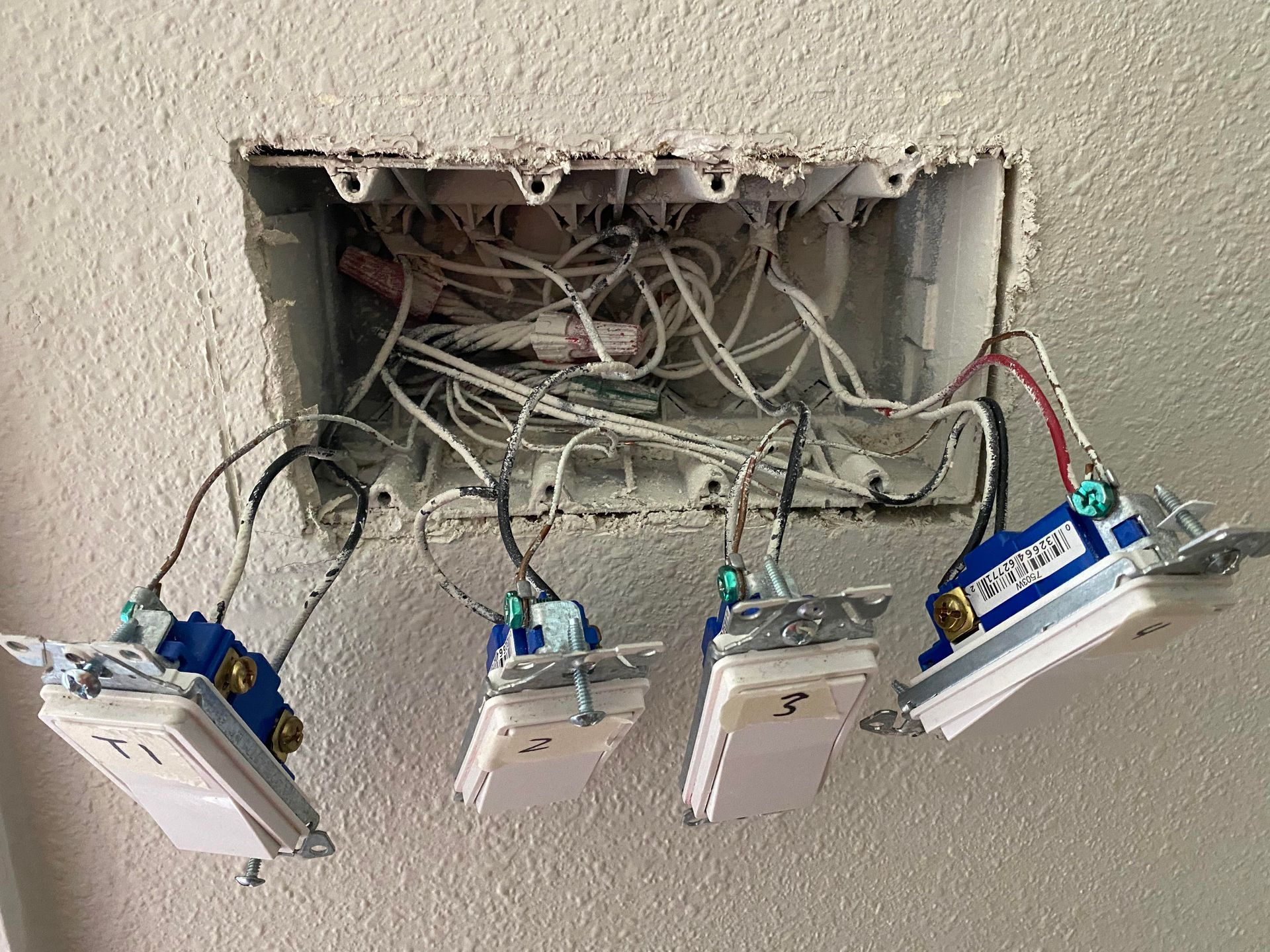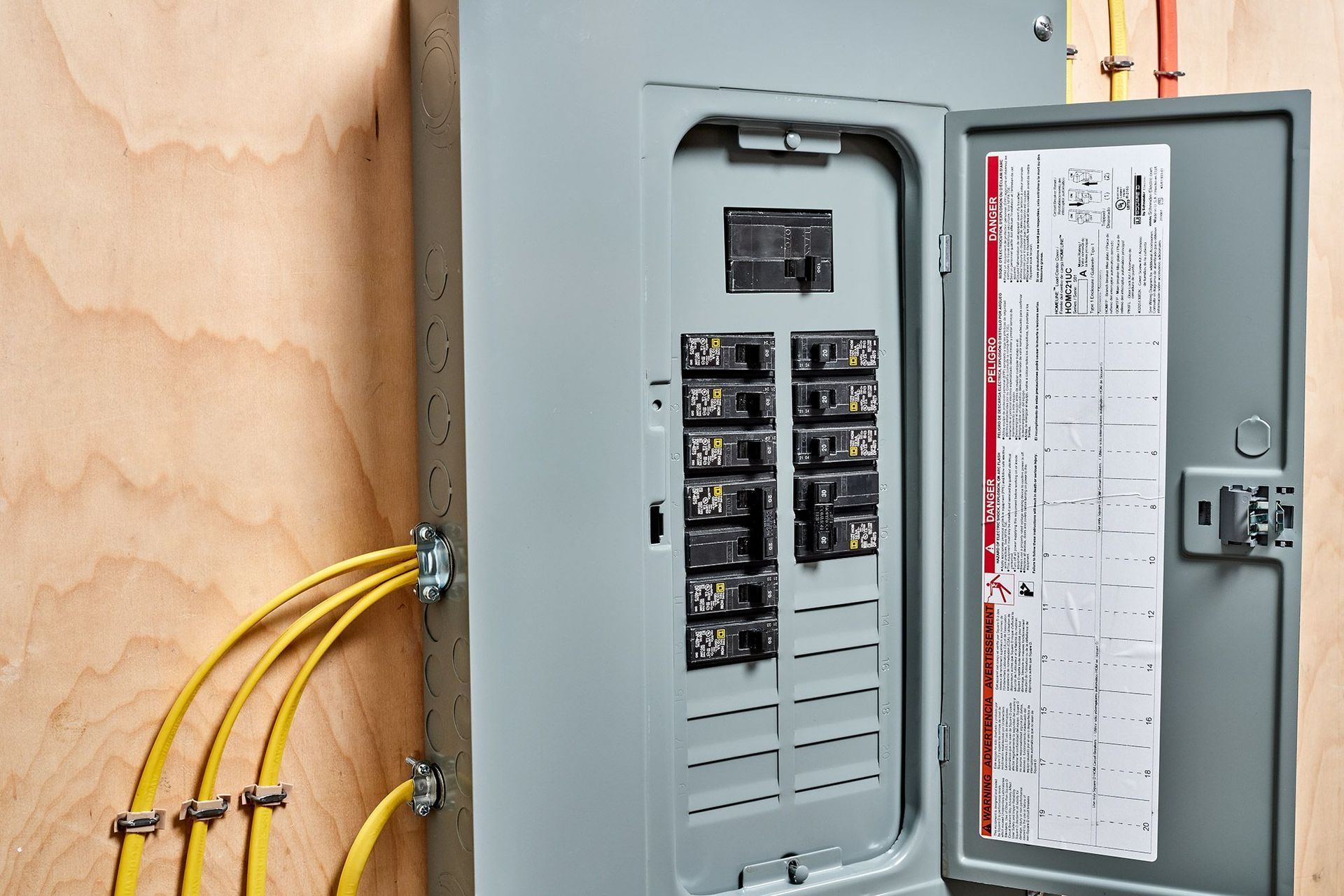Electrical Wiring Colors, which one is hot, neutral & ground for Residential.

Understanding electrical wiring colors is a crucial aspect of any residential electrical project. The colors of the wires play a significant role in identifying the various functions of each wire. Typically, electrical wiring colors include black, red, white, green, and bare copper. The black and red wires are the hot wires, responsible for providing power to the electrical circuit, while the white wire serves as the neutral wire, carrying the current back to the source.
The green wire and the bare copper wire are considered as grounding wires, designed to protect against electrical shocks and fires. Proper identification of the electrical wiring colors is essential to ensure safety, compliance, and efficient functioning of your home's electrical system. As such, it is crucial to work with a licensed electrician who is knowledgeable on the subject.
Hot Wire – Color – Red or Black or Blue
When it comes to residential wiring, understanding the color-coding system for hot wires is crucial for ensuring the proper installation and use of electrical systems. The colors of hot wires used in residential wiring can vary depending on the country and region, but in the United States, the standard color for hot wires is black, red, or blue.
Hot wires are responsible for carrying the electrical current from the power source to your electrical appliances, lighting fixtures, and other devices. It is important to always pay close attention to the color coding of hot wires and to seek the guidance of a certified electrician when making any alteration or repair to the electrical systems in your home. With proper understanding and care, hot wire color in residential wiring can be safely and effectively managed.
Neutral Wire – Color- White or Gray
When it comes to residential wiring, one essential factor to consider is the color coding of wires. The neutral wire plays a significant role in providing a return path for electrical energy to flow safely out of the house. In accordance with the National Electrical Code, the most common color for the neutral wire in residential wiring is white or gray. However, it is important to note that in certain instances, a green or bare wire can also serve as the neutral wire. Proper identification of the electrical wiring colors is essential to ensure safety, compliance, and efficient functioning of your home's electrical system. As such, it is crucial to work with a licensed electrician who is knowledgeable on the subject.
A word of caution: Even if you know these standard wire colors inside and out, working on electrical systems can be complicated—and often dangerous. If you’re not absolutely sure what you’re doing, it’s best to leave electrical work to the professionals. Attempting DIY electrical repairs without the right experience can lead to injury, fire hazards, or costly mistakes. When in doubt, always call a certified electrician to keep your home safe and your wiring up to code.
Hot Wire – Color – Red or Black or Blue
When it comes to residential wiring, understanding the color-coding system for hot wires is crucial for ensuring the proper installation and use of electrical systems. The colors of hot wires used in residential wiring can vary depending on the country and region, but in the United States, the standard color for hot wires is black, red, or blue. Hot wires are responsible for carrying the electrical current from the power source to your electrical appliances, lighting fixtures, and other devices. It is important to always pay close attention to the color coding of hot wires and to seek the guidance of a certified electrician when making any alteration or repair to the electrical systems in your home. With proper understanding and care, hot wire color in residential wiring can be safely and effectively managed.
Neutral Wire – Color- White or Gray
When it comes to residential wiring, one essential factor to consider is the color coding of wires. The neutral wire plays a significant role in providing a return path for electrical energy to flow safely out of the house. In accordance with the National Electrical Code, the most common color for the neutral wire in residential wiring is white or gray.
However, it is important to note that in certain instances, a green or bare wire can also serve as the neutral wire. Proper identification and labeling of electrical wires can help protect you from potential hazards and ensure that your electrical system is functioning efficiently. Whether you are a homeowner or an electrician, it is crucial to keep up to date with the current safety standards in residential wiring, including the identification of neutral wire colors.
Ground Wire – Color- Green or Copper
Ground wire color is a crucial element in residential wiring, as it helps ensure safety and stability in electrical systems. While the standard color for ground wires is green, they can also be bare copper or even yellow with green stripes in some cases. It is essential to follow the national electrical code when identifying and connecting ground wires to avoid electrical hazards and maintain the integrity of the system.
Understanding the proper routing and color coding of ground wires in residential wiring can prevent electrical shocks and fires, ensuring the safe and reliable operation of your home's electrical network.
Bottom line: Knowing your wire colors is only the first step—safe electrical work demands respect for the risks involved and the wisdom to call in a pro when things get tricky.
What color wire is the hot wire?
In residential electrical systems, the hot wire is typically black, red, or sometimes blue.
Hot wires carry electricity from the panel to your outlets, switches, and fixtures. Always treat them as energized.
What color wire is the neutral wire?
Neutral wires are white or gray.
They complete the circuit by carrying current back to the electrical panel. Neutral is not safe to touch — it can still shock you.
What color wire is the ground wire?
Ground wires are green, green with a yellow stripe, or bare copper.
The ground provides a safe path for electricity during faults or short circuits.
Can a white wire ever be used as hot?
Yes — but only in specific situations, such as when a white wire is repurposed as a “switch leg” or part of a multi-wire cable.
When this happens, electricians must mark the white wire with black or red tape to show that it is now a hot conductor.
How are neutral wires repurposed as hot wires and how are they identified?
Repurposing Neutral Wires as Hot Wires
In certain wiring scenarios—such as when updating or extending circuits—it may be necessary to use a neutral wire as a hot wire. This is sometimes seen in switch loops or when additional conductors are needed without replacing the entire cable. When this occurs, strict identification practices must be followed to comply with the National Electrical Code and maintain safety.
If a white (neutral) wire is repurposed as a hot wire, electricians will clearly mark the ends of the wire with black or red electrical tape, or using a permanent marker, to indicate its new function. This visual distinction is required at every termination point—such as in outlets, switches, or breaker boxes—to notify anyone working on the system that the wire no longer serves as neutral.
Never assume a white or gray wire is neutral without checking for these identifying markings. Always verify the purpose of each wire before making any connections. Proper labeling and careful inspection play a key role in avoiding potentially hazardous mistakes during installation or repair.
What safety precautions should be taken when testing electrical wires
Safety Precautions When Testing
Electrical Wires
Safety should always be the top priority when working with electrical wires. Even with a solid understanding of wire colors and their functions, testing wires can present risks if proper procedures aren't followed. Here are important safety steps to observe:
Always Turn Off the Power: Before starting any test or repair, switch off the power at your main breaker or fuse box.
Double-check to ensure the circuit is truly de-energized by using a voltage tester.
Use the Right Tools: Employ insulated tools, such as a quality multimeter set to the appropriate voltage range, to minimize the risk of accidental shocks.
Cap Unused Wires: Secure any wires not being tested with wire nuts or electrical tape to prevent unexpected contact or short circuits.
Test Thoughtfully: Methodically test each wire, keeping your hands dry and avoiding metal jewelry. If a wire gives a reading on your multimeter, it’s live—avoid touching it directly.
Work Methodically: Once your testing is complete, turn the power off again before reconnecting wires or making changes.
When in Doubt, Call a Professional: Even if you're comfortable with these basics, it's best to consult a licensed electrician for any uncertainties or complex situations.
Taking these precautions not only keeps you safe, but also ensures your home's electrical system remains reliable and compliant with code.
How are neutral wires repurposed as positive wires and how are the identified?
Repurposed Neutral Wires: Identification and Safety Considerations
In certain residential wiring scenarios, a neutral wire may be repurposed as a positive (hot) wire to accommodate specialized circuit requirements, such as when converting a standard circuit or installing three-way switches.
Electricians typically signal this change by marking the neutral wire with colored electrical tape—most commonly red or black. For example, if a white wire (ordinarily neutral) is intended to carry current as a hot wire, it must be wrapped at both ends with red or black tape.
This visual cue alerts anyone working on the system that the wire is no longer serving as a neutral and now functions as a hot wire. Such labeling is crucial to prevent confusion and reduce the risk of electrical shock or circuit failure.
Always ensure these modifications comply with the National Electrical Code (NEC), and if you encounter an unfamiliar wire color scheme, consult a licensed electrician for verification before proceeding.
What is the common wire, and what colot is it typically?
Common Wire – What It Is and Its Standard Color
In many residential wiring setups, you may come across the term "common wire," especially when dealing with thermostats or certain electrical systems. The “common wire” is essentially another name for the neutral wire, whose primary function is to complete the electrical circuit by carrying current back to the panel after it has powered a device or fixture.
According to the National Electrical Code, the common (neutral) wire is typically identified by its white or sometimes gray insulation in U.S. Homes. However, improper wiring or older installations may occasionally use different colors, so it's always wise to double-check.
If you're uncertain which wire serves as the common or neutral in your system, enlist the help of a licensed electrician or use a multimeter to test safely. Never assume wire color alone is a guarantee, as correct identification is key to both the safety and efficiency of your electrical project.
How can you identify the common wire using a multimeter?
Identifying the Common Wire with a Multimeter
Identifying the common wire in a residential electrical setup is an important step to ensure proper and safe wiring. If you're working with a multimeter, follow these basic guidelines:
Power Off: Always begin by switching off the power at your breaker box to eliminate the risk of accidental shock.
Prepare Wires: Use wire nuts or electrical tape to safely cap wires you won’t be testing, especially those that might carry current.
Restore Power: After preparing the wires, switch the power back on at the breaker box.
Set Up Your Multimeter: Adjust your digital multimeter to measure voltage—typically the highest DC setting is recommended for initial safety.
Test the Wires: Carefully touch the multimeter’s red probe to the wire in question. If you get a voltage reading, the wire is hot. If there is no voltage reading, this indicates you’ve likely found the common (neutral) wire.
Finalize: Once you've identified the common wire, turn the power off before reconnecting and securing all wires and fixtures.
Always prioritize safety and, when in doubt, consult a licensed electrician before beginning any residential electrical work.
Can a white or gray wire ever be used as ground?
No.
Under NEC rules, white and gray wires are neutral only and cannot be used as ground.
Ground wires must be green, green/yellow, or bare copper.
What if a black wire and white wire are connected together?
This usually indicates that the white wire has been marked or re-identified as hot.
Electricians often do this in switch loops or certain lighting circuits. Look for tape or ink marking the white wire.
What if the wires in my home don’t match standard color codes?
Older homes, DIY work, or mixed cable types may have inconsistent colors.
If you find mismatched or confusing wiring, do not rely on color alone—always test with a voltage tester or call a licensed electrician.
Are wiring colors the same in every country?
No. Color codes vary widely.
For example, Europe uses brown (hot), blue (neutral), and green/yellow (ground).
This FAQ covers U.S. residential wiring based on NEC standards only.
Why do some cables have multiple hot colors?
Describe the item or answer the question so that site visitors who are interested get more information. You can emphasize this text with bullets, italics or bold, and add links.Why do some cables have multiple hot colors?
Multi-wire cables (such as 12/3 or 14/3) often include black, red, and sometimes blue conductors. These are used for: 3-way switches Multi-circuit runs 240-volt appliances Smart-switch wiring
How can I tell which wire is hot if colors are faded or old?
Use a non-contact voltage tester.
It’s the safest way to confirm which conductor carries live voltage, especially in older homes where insulation colors may not be reliable.

US AC Electrical power circuit wiring color codes
The protective ground is green or green with yellow stripes. The neutral is white, the hot (live or active) single phase wires are black, and red in the case of a second active. The three-phase lines are red, black, and blue.
Electrical Wiring Color Code Standards
Electrical wiring color code standards are essential to ensuring safe and reliable electrical installations. Having a standard set of colors for wires helps electricians and homeowners alike to avoid costly mistakes and potential safety hazards. In the United States, the National Electrical Code outlines specific colors to be used for different types of wires and circuits. For example, black wires are typically used for hot wires, white wires for neutral, and green or bare wires for ground. It's crucial to follow these color codes when working with electrical installations, as any deviation from these standards can result in a dangerous situation. By adhering to electrical wiring color code standards, you can ensure a safe and efficient electrical system.
Why You Should Choose AC-DC Electric
If you’re still having trouble finding the right electrician to help you with your residential electrical issues, consider contacting AC-DC Electric. We maintain a network of reliable and affordable electricians who can offer assistance.
Our Experience
At AC-DC Electric, we have been offering both residential and commercial electrical services for over four decades. Our experience has taught us the best ways to perform various procedures.
Our management and staff have seen electric systems evolve over time and have gained a deeper understanding of how they work. Thanks to our experience, we rarely encounter issues that we have never seen before.
Our knowledge
Each of our electricians and technicians is licensed, certified, and trained to provide high quality services. We understand the importance that electric systems play in both residential and commercial properties. This is why we handpick the best staff who are both knowledgeable and have demonstrated their ability in a variety of situations.
At AC-DC Electric, we foster an environment that encourages excellence. You can count on our electricians and technicians to get the job done with both speed and skill.
Our Transparent Pricing
Dealing with an electrical problem at home can be incredibly distressing, and many electricians and companies are willing to exploit people experiencing such issues by charging them high fees. At AC-DC Electric, we strive to provide high quality services at affordable rates.
Our experts can also offer you a free estimate before you hire them. This ensures you remain aware of how much you will need to pay before using our services.
If you’re ready to tackle your residential property’s electrical problems quickly, please contact AC-DC Electric today. Our experts are always happy and ready to help residents in
Denver,
Lakewood,
Thornton,
Fort Collins, Greeley, Evans, Johnstown & Windsor. Call today for a free estimate at 970-330-1656.
You might also like




